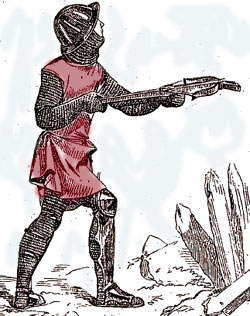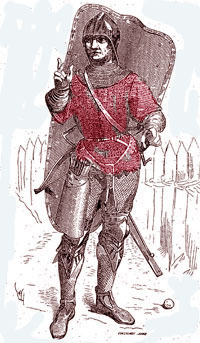Medieval Infantry Armor
The Medieval infantry armor was somehow intended to mimic that of the Medieval knights. But how complete was the actual infantry man armor depended exclusively upon the means of the soldiers. They could wear what they could afford. The Bayeux tapestry is showing that in Duke William’s army only the nobles had their legs protected by chain mail armor. The common soldiers wore linen or leather swathings, sometimes studded with metal.

Crossbowman Armor with
Chapelle de fer
Medieval Infantry Armor Components
It is known that in 1181, Henry II raised a permanent infantry force. Every member, the burgess or the freeman, was compelled to wear an armor composed of an iron helmet, and either a chain mail hauberk , or if he could not afford it, at least a gambeson. During the times of Richard I, the infantry armor consisted of a helmet, coat of mail, and quilted defenses made of many folds of linen which were hard to penetrate. The infantry man also had a shield, usually held in the left hand. The foot soldiers generally used the round shield.
Infantry Medieval Armor - ProvenienceFor quite a long time during the Middle Ages, the infantry and light troops were left to arm themselves as best as they could, depending on their financial means. As most of the time these were scarce, any opportunity to improve an infantry man armor for cheap was welcome.
The foot archers at Agincourt were left to pick up any kind of helmet, bascinet, or cap, whether of leather or iron, and any side arms, simply because they were mostly without armor, except a simple pourpointerie (fabric studded with metal). For them to go to war, only the bows, arrows, and stakes were mandatory. As victors, it was the time to equip themselves to a higher standard .
The main source of supplying the armor for the Medieval infantry were the changes in warfare fashion. Every time new models of Medieval armor appeared, the knights were the first to adopt them. The old equipment was quickly considered obsolete, and it was relegated to be used as infantry armor.
As a result, the Medieval foot soldiers were generally equipped with various hauberks of mail, old brigandines and gambesons, bits of plate, or “jakkes” of linen.
Medieval Infantry Types of Armor
A special category of Middle Ages foot soldiers were the crossbowmen and the archers. The equipment of the 13th century crossbowmen consisted of complete chain mail with the surcoat over it. Towards the middle of the century, the chapelle de fer was introduced. This type of helmet was considered more appropriate for the crossbowmen as it allowed good vision, and in the same time protected against blows from above. The chapelle de fer sometimes had a crossed reinforcement.
The transitional knight armor was adopted in a simplified form, and the body defense was ensured by a mixture of mail and plate. Around 1320, a new body armor appeared. Named brigandine, this defense was lighter than the chain mail armor, and quickly became a favorite of the Medieval foot soldiers, including the crossbowmen. The helmet was worn with a fixed camail, and the legs were protected by mail armor (chausses). The knees were protected by plates named poleyns, and below the knees, the legs were also protected by plate armor, which could have front and back pieces (greaves), or only front plates laced at the back (schynbalds).
Medieval Genoese Infantry ArmorAn interesting example of the Medieval foot soldier armor is the Genoese Crossbowman. The Genoese fought at Crécy. They had a very heavy equipment. Besides the crossbow itself and the bolts (or quarrels), they carried a large shield (pavise), designed to protect the entire body. As the crossbowmen were essentially static troops (until they started to fight mounted in the 15th century) the pavise was protecting the soldier while loading. The head was protected by a bascinet with camail armor.

Medieval Infantry
Genoese Crossbowman Armor
They wore the brigandine and the chain mail armor, and their knees were protected by plate armor. The brigandine had metal plates riveted under the quilted fabric. Sometimes, the material could be canvas or leather. Together with the long sword, the weight of their equipment could easily reach 60 pounds.
Medieval Armor of Royal Infantry BodyguardsThe Medieval infantry armor varied little during the 15th century. However, there were exceptions, like the bodyguards to Charles VII., Louis XI, or Henry VII. The Medieval armor of these infantry soldiers became distinctive, and even sumptuous. They were actually wearing uniforms, and were armed with carefully selected standardized weapons.
The equipment of these troops were splendid examples of Medieval infantry armor. The brigandines were covered with black velvet and gilt nails, and the hoods ornamented with silver gilt tassels. The infantry soldiers designated to protect the royals could also wear plate armor under jackets of various colors, with greaves, swords, daggers and helms richly decorated.
